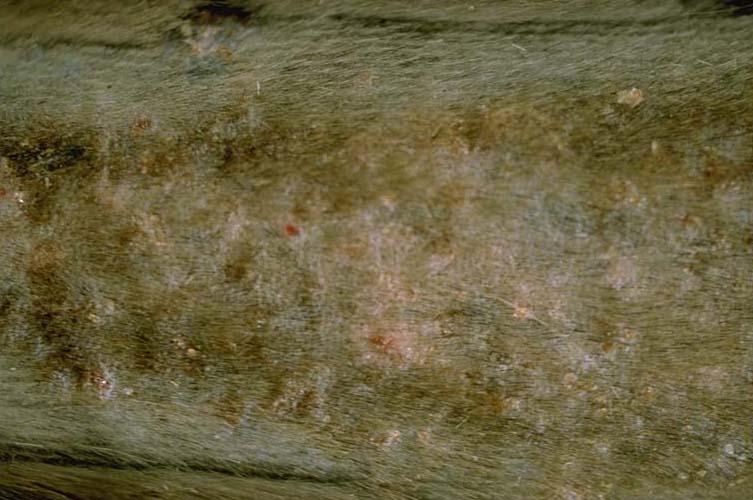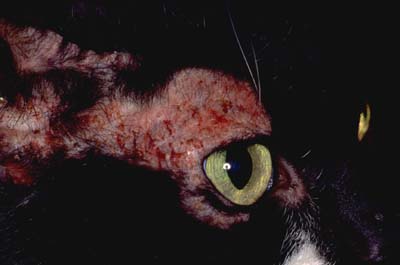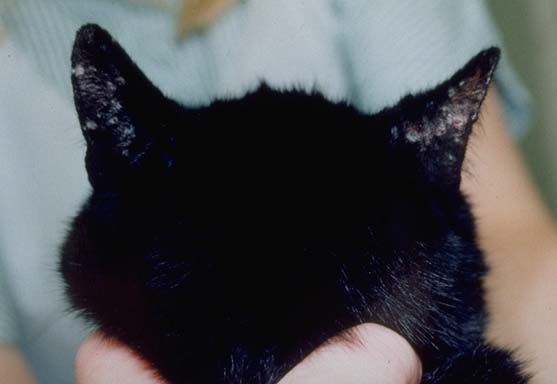Flea bite hypersensitivity
Introduction
- Most common cause of skin disease in cats.
- Cause: sensitization to flea salivary allergens.
- Signs: miliary dermatitis Dermatitis: miliary, symmetrical alopecia, eosinophilic skin disease or any combination.
- Diagnosis: evidence of fleas + response to flea control +/- positive reaction to intradermal flea antigen.
- Treatment: flea control.
- Prognosis: excellent.
Print off the Owner factsheet on All about fleas All about fleas to give to your client.
Presenting signs
- Miliary dermatitis Dermatitis: miliary

 .
. - Alopecia Alopecia: overview.
- Eosinophilic skin disease Eosinophilic granuloma complex.
- Any combination of above clinical presentations.
Geographic incidence
- Wherever fleas are found.
Cost considerations
- Long-term control programs necessary, can be costly in multi-animal households.
Pathogenesis
Etiology
- Ctenocephalides felis (most common) Ctenocephalides felis.
- Ctenocephalides canis (rare) Ctenocephalides canis.
- Pulex irritans (rare).
- Psilopsyllus cuniculi
 (rare).
(rare). - Archeopsylla erinacei (rare).
Predisposing factors
General
- Contact with fleas.
- Multi-animal households.
- Contact with free-ranging cats.
- History of exposure to the tapeworm Dipylidium caninum, for which the flea is the intermediate host Dipylidium caninum.
- Other allergic skin disease (atopy Skin: atopic dermatitis, food hypersensitivity Food hypersensitivity).
- Moving from a low exposure to fleas to a high exposure, eg cold to a warm area.
- Intermittent flea exposure.
Pathophysiology
- Hypersensitivity is triggered by flea salivary proteins.
- Most cats show an IgE immediate-type hypersensitivity reaction. Flea bite → development of weal and flare within 15-30 min (persists for up to 72 hours) → pruritus → miliary dermatitis, alopecia or eosinophilic skin disease.
- In other species there is evidence that a small number of animals show a delayed reaction (probably lymphocyte mediated) at 24-72 hours post-bite.
- Others show a late-phase IgE reaction which is basophil mediated at approximately 6 hours post-bite.
Epidemiology
Diagnosis
Subscribe To View
This article is available to subscribers.
Try a free trial today or contact us for more information.
Treatment
Subscribe To View
This article is available to subscribers.
Try a free trial today or contact us for more information.
Prevention
Subscribe To View
This article is available to subscribers.
Try a free trial today or contact us for more information.
Outcomes
Subscribe To View
This article is available to subscribers.
Try a free trial today or contact us for more information.
Further Reading
Publications
Refereed papers
- Recent references from PubMed and VetMedResource.
- Kunkle G A, McCall C A, Stedman K E et al (2003) Pilot study to assess the effects of early flea exposure on the development of flea hypersensitivity in cats. J Feline Med Surg 5 (5), 287-294 PubMed.
- Colombini S, Hodgin E C, Foil C S et al (2001) Induction of feline flea allergy dermatitis and the incidence and histopathological characteristics of concurrent indolent lip ulcers. Vet Dermatol 12 (3), 155-161 PubMed.
- Boy M G, Six R H, Thomas C A et al (2000) Efficacy and safety of selamectin against fleas and heartworms in dogs and cats presented as veterinary patients in North America. Vet Parasitol 91 (3-4), 233-250 PubMed.
- Lee S E, Johnstone I E, Lee R P et al (1999) Putative salivary allergens of the cat flea, Ctenocephalides felis felis. Vet Immunol Immunopathol 69 (2-4), 229-237 PubMed.
- Blagburn B L, Vaughan J L, Lindsay D S et al (1994) Efficacy of lufenuron against developmental stages of fleas (Ctenocephalides felis felis) in cats. Am J Vet Res 55 (1), 98-101 PubMed.
- McKeon S E & Opdebeeck J P (1994) IgG and IgE antibodies against antigens of the cat flea, Ctenocephalides felis sera of allergic and non-allergic dogs. Int J Parasitol 24 (2), 259-263 PubMed.
- Mason K V & Evans A G (1991) Mosquito bite-caused eosinophilic dermatitis in cats. JAVMA 198 (12), 2086-2088 PubMed.
- Plant J D (1991) Recognizing the manifestations of flea allergy in cats. Vet Med 86 (5), 482-486 VetMedResource.
- Moriello K A & McMurdy M A (1989) Feline flea allergy dermatitis - Practice tips on making a diagnosis. Comp An Pract 19 (4-5), 23-27 VetMedResource.